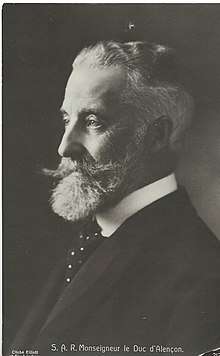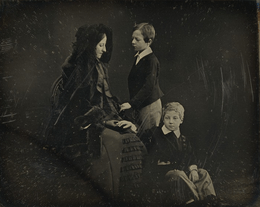Prince Ferdinand, Duke of Alençon
Ferdinand Philippe Marie d'Orléans, duc d'Alençon (12 July 1844 – 29 June 1910) was the son of Louis Charles Philippe Raphael d'Orléans, Duke of Nemours and Princess Victoria of Saxe-Coburg and Gotha (a first cousin of Britain's Queen Victoria).
| Prince Ferdinand | |||||
|---|---|---|---|---|---|
| Duke of Alençon | |||||
 | |||||
| Born | 12 July 1844 | ||||
| Died | 29 June 1910 (aged 65) | ||||
| Burial | Royal Chapel, Dreux, France | ||||
| Spouse | |||||
| Issue | Louise, Princess Alfons of Bavaria Prince Emmanuel, Duke of Vendôme | ||||
| |||||
| House | Orléans | ||||
| Father | Prince Louis, Duke of Nemours | ||||
| Mother | Princess Victoria of Saxe-Coburg and Gotha | ||||
| Religion | Roman Catholicism | ||||
| Signature | |||||
Early life

Prince Ferdinand of Orléans was born on 12 July 1844.[1] He was the son of Prince Louis, Duke of Nemours, and Princess Victoria of Saxe-Coburg and Gotha, cousin of Queen Victoria.[2] Among his siblings was older brother Prince Gaston of Orleans, Count of Eu, the Imperial consort of Brazil (through his marriage to Isabel, Princess Imperial of Brazil), and younger sister Princess Marguerite Adélaïde of Orléans, wife of Prince Władysław Czartoryski.[3]
His paternal grandparents were Maria Amalia of Naples and Sicily, Queen consort of the French, and King Louis Philippe, who was forced to abdicate after the outbreak of the French Revolution of 1848.[3]
His maternal grandparents were Prince Ferdinand of Saxe-Coburg and Gotha and Princess Maria Antonia Koháry.[3]
Personal life
On 28 September 1868, he married Sophie Charlotte Augustine, Duchess in Bavaria (1847–1897) at Possenhofen Castle, near Starnberg.[4] Sophie, the ninth of ten children born to Duke Maximilian Joseph in Bavaria and Princess Ludovika of Bavaria, was a sister of Empress Elisabeth of Austria, Queen Maria Sophie of the Two Sicilies, and Duchess Mathilde Ludovika in Bavaria, the wife of Neapolitan Prince Luis of the Two Sicilies. Before their marriage, she had been engaged to King Ludwig II of Bavaria, but the King called off the engagement before the marriage.[5] The year after their marriage, the ducal couple moved into Bushy House in the Teddington area of Southwest London. The couple had two children:
- Louise d'Orléans (1869–1952), who married Prince Alfons of Bavaria (1862–1933) and had children.
- Emmanuel d'Orléans (1872–1931), duke of Vendôme, who married Princess Henriette of Belgium (1870–1948) and had children.
His wife died in a fire at the Bazar de la Charité in Paris on 4 May 1897.[3] He died in Royal Chapel, Dreux, France on 29 June 1910.[6]
References
- Lodge, Edmund (1845). The Peerage of the British Empire as at Present Existing Arranged and Printed from the Personal Communications of the Nobility by Edmund Lodge Esq. Saunders and Otley Conduit Street. p. 73. Retrieved 21 June 2019.
- Towned (of Brighton.), William (1858). The Descendants of the Stuarts. An unchronicled page in England's History. p. 23. Retrieved 21 June 2019.
- The American Almanac, Year-book, Cyclopedia and Atlas. New York American and journal. 1904. p. 144. Retrieved 21 June 2019.
- Thom, Alexander (1876). Thom's Irish Almanac and Official Directory of the United Kingdom of Great Britain and Ireland for the Year 1879. Dublin: Longmans & Co., and Simpkin, Marshall, & Co. p. 65. Retrieved 21 June 2019.
- "Der Mythos vom Märchenkönig". focus.de. 2010-06-12. Retrieved 2011-06-14.
- de Ruvigny Ruvigny and Raineval (9th marquis of), Melville Amadeus Henry Douglas Heddle de La Caillemotte de Massue (1914). The Titled Nobility of Europe: An International Peerage, Or "Who's Who", of the Sovereigns, Princes and Nobles of Europe. Harrison & Sons. p. 40. Retrieved 21 June 2019.
Ancestry
| Ancestors of Prince Ferdinand, Duke of Alençon | |||||||||||||||||||||||||||||||||||||||||||||||||||||||||||||||||||||||||||||||||||||||||||||||||||||||||||||||||||||||||||||||||||||||||||||||||||||||||||||||||||||||||||||||||||||||||||||||||||||||||||||||||||||||||||||||||||||||||||||||||||||||||||||||||||||||||||||||||||||||||
|---|---|---|---|---|---|---|---|---|---|---|---|---|---|---|---|---|---|---|---|---|---|---|---|---|---|---|---|---|---|---|---|---|---|---|---|---|---|---|---|---|---|---|---|---|---|---|---|---|---|---|---|---|---|---|---|---|---|---|---|---|---|---|---|---|---|---|---|---|---|---|---|---|---|---|---|---|---|---|---|---|---|---|---|---|---|---|---|---|---|---|---|---|---|---|---|---|---|---|---|---|---|---|---|---|---|---|---|---|---|---|---|---|---|---|---|---|---|---|---|---|---|---|---|---|---|---|---|---|---|---|---|---|---|---|---|---|---|---|---|---|---|---|---|---|---|---|---|---|---|---|---|---|---|---|---|---|---|---|---|---|---|---|---|---|---|---|---|---|---|---|---|---|---|---|---|---|---|---|---|---|---|---|---|---|---|---|---|---|---|---|---|---|---|---|---|---|---|---|---|---|---|---|---|---|---|---|---|---|---|---|---|---|---|---|---|---|---|---|---|---|---|---|---|---|---|---|---|---|---|---|---|---|---|---|---|---|---|---|---|---|---|---|---|---|---|---|---|---|---|---|---|---|---|---|---|---|---|---|---|---|---|---|---|---|---|---|---|---|---|---|---|---|---|---|---|---|---|---|---|---|---|
| |||||||||||||||||||||||||||||||||||||||||||||||||||||||||||||||||||||||||||||||||||||||||||||||||||||||||||||||||||||||||||||||||||||||||||||||||||||||||||||||||||||||||||||||||||||||||||||||||||||||||||||||||||||||||||||||||||||||||||||||||||||||||||||||||||||||||||||||||||||||||
